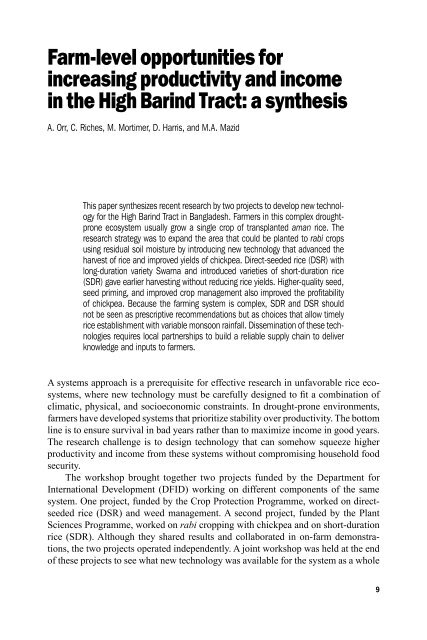Download (2461kB) - University of Greenwich
Download (2461kB) - University of Greenwich
Download (2461kB) - University of Greenwich
- No tags were found...
Create successful ePaper yourself
Turn your PDF publications into a flip-book with our unique Google optimized e-Paper software.
Farm-level opportunities forincreasing productivity and incomein the High Barind Tract: a synthesisA. Orr, C. Riches, M. Mortimer, D. Harris, and M.A. MazidThis paper synthesizes recent research by two projects to develop new technologyfor the High Barind Tract in Bangladesh. Farmers in this complex droughtproneecosystem usually grow a single crop <strong>of</strong> transplanted aman rice. Theresearch strategy was to expand the area that could be planted to rabi cropsusing residual soil moisture by introducing new technology that advanced theharvest <strong>of</strong> rice and improved yields <strong>of</strong> chickpea. Direct-seeded rice (DSR) withlong-duration variety Swarna and introduced varieties <strong>of</strong> short-duration rice(SDR) gave earlier harvesting without reducing rice yields. Higher-quality seed,seed priming, and improved crop management also improved the pr<strong>of</strong>itability<strong>of</strong> chickpea. Because the farming system is complex, SDR and DSR shouldnot be seen as prescriptive recommendations but as choices that allow timelyrice establishment with variable monsoon rainfall. Dissemination <strong>of</strong> these technologiesrequires local partnerships to build a reliable supply chain to deliverknowledge and inputs to farmers.A systems approach is a prerequisite for effective research in unfavorable rice ecosystems,where new technology must be carefully designed to fit a combination <strong>of</strong>climatic, physical, and socioeconomic constraints. In drought-prone environments,farmers have developed systems that prioritize stability over productivity. The bottomline is to ensure survival in bad years rather than to maximize income in good years.The research challenge is to design technology that can somehow squeeze higherproductivity and income from these systems without compromising household foodsecurity.The workshop brought together two projects funded by the Department forInternational Development (DFID) working on different components <strong>of</strong> the samesystem. One project, funded by the Crop Protection Programme, worked on directseededrice (DSR) and weed management. A second project, funded by the PlantSciences Programme, worked on rabi cropping with chickpea and on short-durationrice (SDR). Although they shared results and collaborated in on-farm demonstrations,the two projects operated independently. A joint workshop was held at the end<strong>of</strong> these projects to see what new technology was available for the system as a whole
















